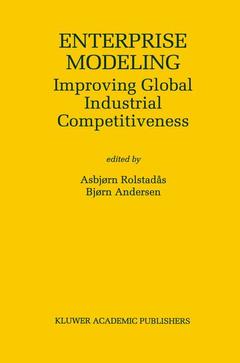Description
Enterprise Modeling, Softcover reprint of the original 1st ed. 2000
Improving Global Industrial Competitiveness
The Springer International Series in Engineering and Computer Science Series, Vol. 560
Coordinators: Rolstadås Asbjørn, Andersen B.
Language: English
Subject for Enterprise Modeling:
Keywords
Management; Performance; Text; architecture; information system; modeling; organization
Enterprise Modeling
Publication date: 10-2012
333 p. · 15.5x23.5 cm · Paperback
Publication date: 10-2012
333 p. · 15.5x23.5 cm · Paperback
Enterprise modeling,improving global industrial competitiveness
Publication date: 07-2000
333 p. · 15.5x23.5 cm · Hardback
Publication date: 07-2000
333 p. · 15.5x23.5 cm · Hardback
Description
/li>Contents
/li>
Enterprise Modeling: Improving Global Industrial Competitiveness gives an overview of the current state-of-the-art in enterprise modeling and its application. Enterprise modeling is both a concept and a tool that is highly developed at the research level, but which still promises many new industrial applications. Enterprise models constitute a theoretical basis for the information system in an enterprise and are regarded by many as a substantial opportunity to improve global industrial competitiveness.
Enterprise Modeling: Improving Global Industrial Competitiveness gives the reader an understanding of enterprise modeling as a concept and provides examples of its application by describing some of the currently available tools. It is organized in five parts: overview and international trends, the basis of enterprise modeling, application areas, implementation, and industrial experience with enterprise modeling. Enterprise Modeling: Improving Global IndustrialCompetitiveness is useful to developers of business information systems, users of technical information systems, engineers within operations management, and engineers and economists dealing with performance assessment and improvement.
Enterprise Modeling: Improving Global Industrial Competitiveness is suitable as a secondary text for a graduate level course, and as a reference for researchers and practitioners in industry.
Enterprise Modeling: Improving Global Industrial Competitiveness gives the reader an understanding of enterprise modeling as a concept and provides examples of its application by describing some of the currently available tools. It is organized in five parts: overview and international trends, the basis of enterprise modeling, application areas, implementation, and industrial experience with enterprise modeling. Enterprise Modeling: Improving Global IndustrialCompetitiveness is useful to developers of business information systems, users of technical information systems, engineers within operations management, and engineers and economists dealing with performance assessment and improvement.
Enterprise Modeling: Improving Global Industrial Competitiveness is suitable as a secondary text for a graduate level course, and as a reference for researchers and practitioners in industry.
Contributors. Preface. 1. Development Trends to Support Enterprise Modeling; A. Rolstadås. 2. Reader's Guide to the Book; A. Rolstadås. 3. Introduction to Enterprise Modeling; O. Szegheo. 4. Enterprise Modeling Architectures; O. Szegheo, A. Gastinger. 5. Enterprise Modeling Approaches; A. Gastinger, O. Szegheo. 6. Enterprise Modeling Tools; A. Gastinger, O. Szegheo. 7. Modeling for Performance Measurement of Enterprises; Wei Deng Solvang. 8. Enterprise Modeling for Self-assessment; T. Fagerhaug. 9. Enterprise Modeling for Enterprise Integration; C.C. Røstad. 10. Enterprise Modeling for Business Process Improvement; B. Andersen. 11. The Process of Enterprise Development; E. Alfnes. 12. Enterprise Modeling and Education; C. Solberg. 13. Product Data Management Systems; O. Åsebø. 14. Modeling and Simulation; O. Szegheo, K. Martinsen. 15. Modeling of the Extended Enterprise; O. Szegheo, S. Abbas Petersen. 16. Putting the Pieces Together; B. Andersen. 17. Organizational Aspects of Implementing Enterprise Modeling; R. Hysom. 18. IT-platforms for Enterprise Modeling; C. Solberg. 19. Using Enterprise Models for Managing Large-scale Business Transformations and Enterprise Integration; V. Orovic, D. George. 20. Integrated Enterprise Modeling; K. Mertins, R. Jochem. References. Index.
© 2024 LAVOISIER S.A.S.



